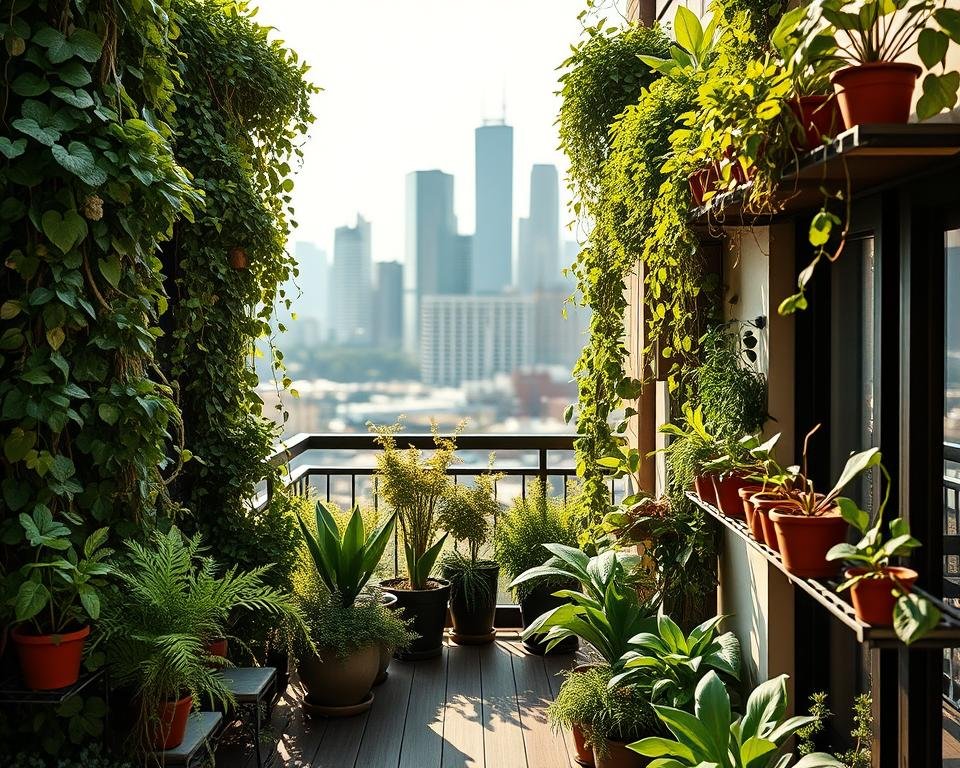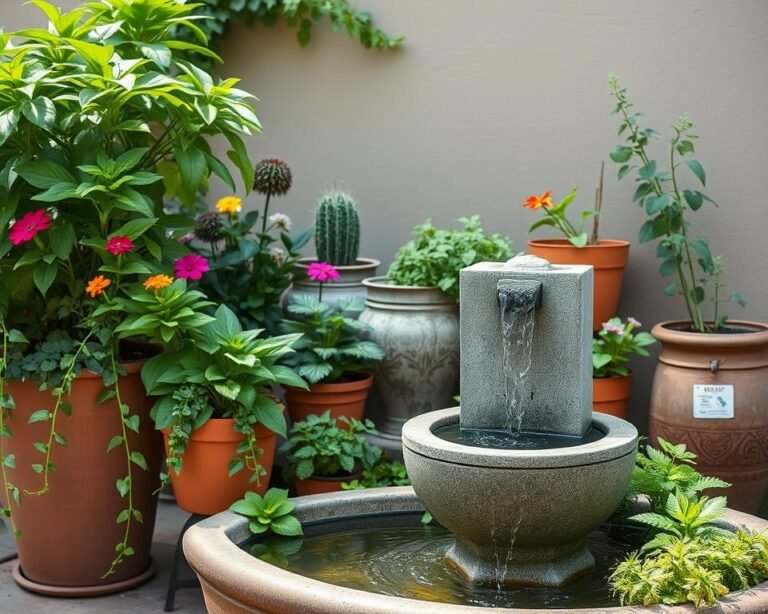Vertical Basics: Beginner’s Guide to Vertical Gardening
When I first stepped onto my tiny balcony, traditional gardening seemed impossible. That’s when I discovered Vertical Basics—a straightforward approach that turns even the smallest spaces into productive gardens.
More than a passing trend, Vertical Basics teaches you how to grow upward, not outward, making city living greener and more rewarding. By following these simple principles, you can transform balconies, patios, or kitchen walls into thriving green sanctuaries.
Urban gardeners everywhere use Vertical Basics to maximise limited square footage, harvest fresh produce, and create lush oases in unexpected places. With the right guidance, anyone can master vertical gardening and watch their plants—and possibilities—reach new heights.
Key Takeaways
- Vertical gardening saves up to 80% of traditional gardening space
- Perfect for urban environments with limited growing areas
- Can increase produce yield by 20% compared to ground gardens
- Improves urban biodiversity and reduces local heat
- Suitable for beginners with various plant options
Understanding Vertical Basics
Vertical gardening is a new way to grow plants in small spaces. It’s perfect for crowded cities. It helps produce food and improve the environment.
What is Vertical Gardening?
Vertical gardening grows plants up instead of out. It uses walls and towers to save space. This method lets you grow many plants in a small area.
- Utilizes minimal floor space
- Enables growing in urban environments
- Supports diverse plant cultivation
- Reduces traditional land requirements
Space-Saving Benefits
People living in cities can turn small areas into gardens. Vertical basics let you grow many plants in a small space. This makes gardening easy for anyone, no matter where they live.
“Vertical gardening turns limitations into opportunities for growth and sustainability.” – Urban Agriculture Experts
Environmental Impact
Green walls and vertical farming help cities a lot. They clean the air and cool down the city. They also help local animals by providing homes.
| Environmental Benefit | Impact |
|---|---|
| Air Quality Improvement | Reduces pollutants, increases oxygen |
| Urban Cooling | Lowers local temperature by 2-3 degrees |
| Biodiversity Support | Creates habitats for urban wildlife |
Essential Equipment and Structures for Vertical Growing
Vertical gardening turns small spaces into green oases. It’s perfect for urban farming, making your space a plant factory. Vertical gardening techniques let you grow plants in much smaller areas than before.
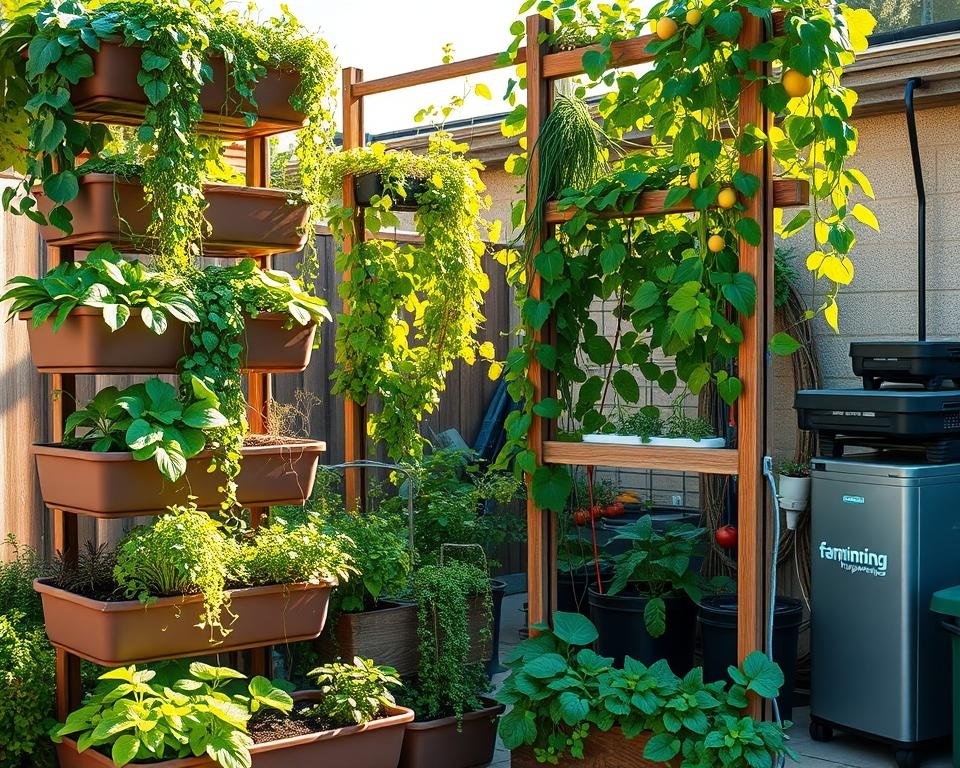
- Vertical Planters
- Trellises and Arbors
- Wall-Mounted Gardens
- Hanging Basket Systems
- Hydroponic and Aeroponic Setups
Choosing the right vertical gardening system is key. Hydroponic systems are great for urban farming, growing plants without soil. Aeroponic systems go further, suspending plants in air and misting their roots.
| Structure Type | Best For | Space Requirement |
|---|---|---|
| Vertical Planter Boxes | Herbs, Leafy Greens | Small Balconies |
| Trellis Systems | Climbing Vegetables | Walls, Fences |
| Hanging Gardens | Trailing Plants | Overhead Spaces |
Pro Tip: Choose structures that provide adequate sunlight and support for your specific plant varieties.
DIY fans can make vertical gardens from recycled stuff like pallets or gutters. Whether you have a small apartment or a tiny backyard, vertical gardening opens up new ways to grow your own food.
Best Plants for Vertical Gardens
Vertical gardening lets you grow plants in small spaces. It turns walls and tiny areas into lush green spots. The trick is picking plants that do well in these tight spots.
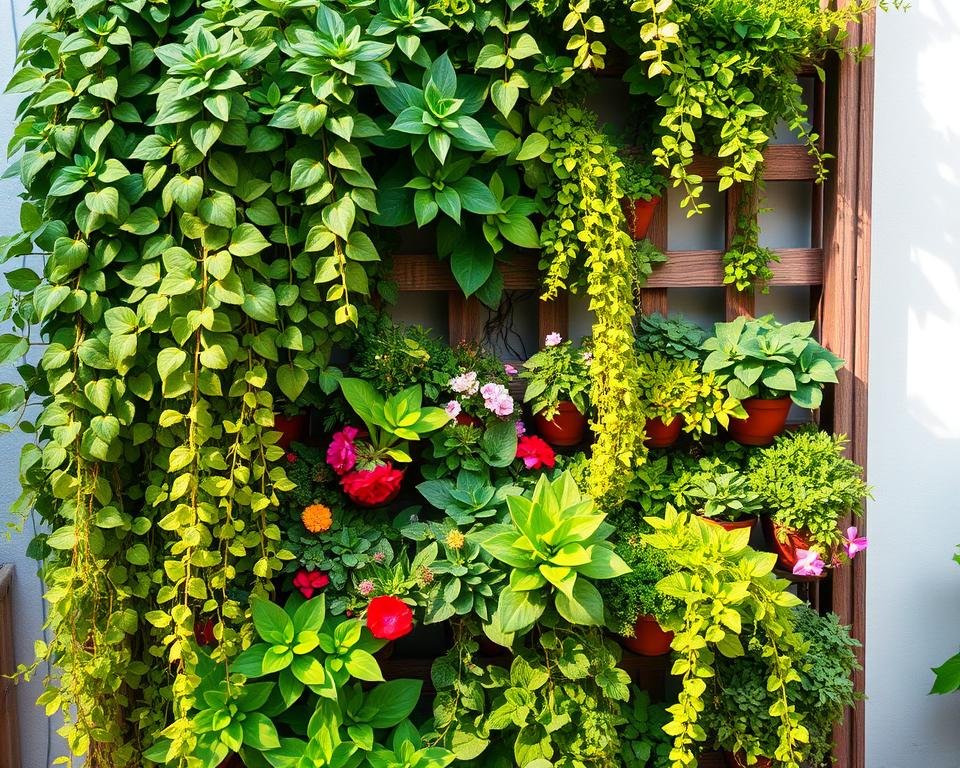
Choose the right plants for a lush and useful vertical garden. Soilless methods help grow many types of plants in small areas.
Climbing Vegetables
Some veggies love vertical gardens, making the most of your space:
- Indeterminate tomatoes
- Pole beans
- Cucumbers
- Zucchini
“Vertical gardening allows you to grow more food in less space, transforming urban environments into productive green spaces.”
Herbs and Leafy Greens
Herbs and leafy greens are great for vertical gardens because they grow small:
- Basil
- Mint
- Thyme
- Lettuce
- Spinach
Flowering Plants and Vines
Add beauty to your vertical garden with these flowers:
- Petunias
- Morning glories
- Climbing roses
- Jasmine
Think about light, water, and how plants grow when picking for your garden. Some plants, like strawberries, hang down, perfect for vertical gardens.
With the right plan and plants, your vertical garden will be a green oasis in the city.
Setting Up Your First Vertical Garden
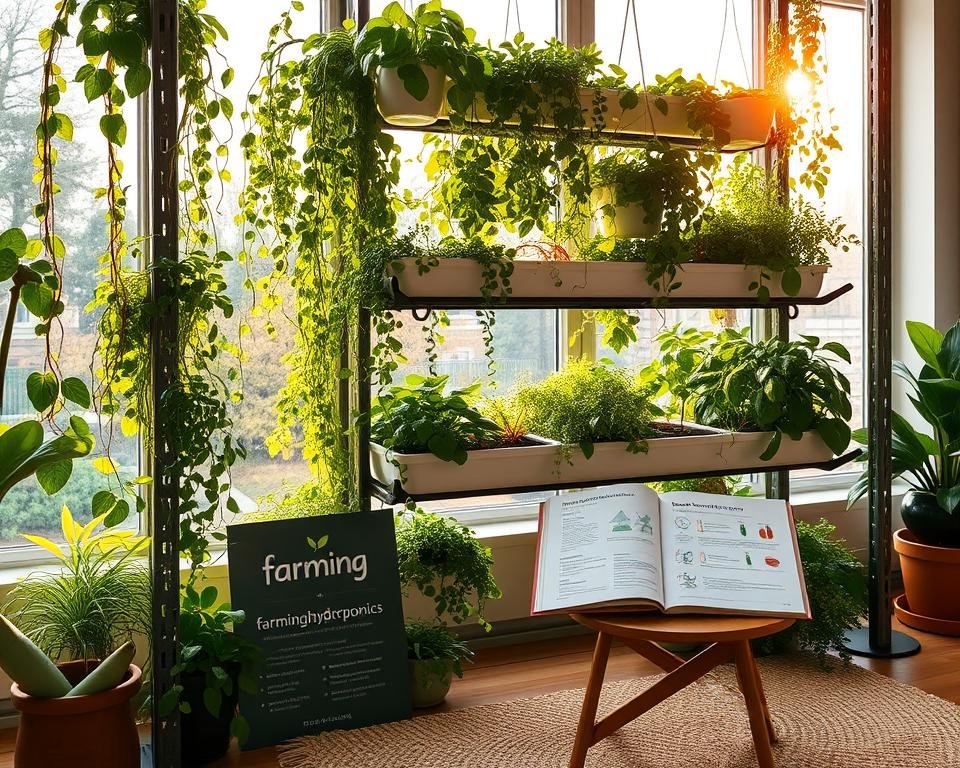
Starting your vertical garden journey can turn your home into a green oasis. This guide will help you create a lush vertical garden. It will show you how to make the most of your space.
First, pick the best spot for your vertical garden. Think about these important things:
- Sunlight exposure (6-8 hours of direct light is ideal)
- Structural support for your vertical structure
- Accessibility for maintenance
- Proximity to water source
Choose plants that are good for vertical gardens. Shallow-rooted plants work best. Some examples are:
- Leafy greens (lettuce, spinach)
- Herbs (mint, parsley, rosemary)
- Vining vegetables (pole beans, climbing peas)
“Vertical gardening is not just about growing plants—it’s about reimagining your space.” – Urban Gardening Expert
When setting up your structure, use strong materials and install it right. DIY fans might like using untreated wooden pallets. Make sure your garden can hold the weight of grown plants and has good drainage.
Water management is key in vertical gardening. Use a drip irrigation system to water your plants well. This saves water and makes sure plants get enough.
With good planning and creativity, your vertical garden will be a lively, space-saving part of your home.
Conclusion
As you’ve explored vertical gardening, you’ve seen a new way to farm sustainably. This method is not just pretty; it’s also practical. It uses space in cities better than ever before.
Vertical gardens can make your home better. They clean the air by up to 30% indoors. Outdoors, they can cool the air by 10°F. They look great and help the planet, using up to 90% less water than old ways.
Vertical gardening is more than a hobby; it’s a step towards a greener future. The market for vertical gardens is growing fast, by 10% each year. It’s a way to make your space green and help the city.
Begin your vertical gardening journey today. You’ll create a beautiful space, grow your own food, and help the planet. It’s a rewarding way to live sustainably.

